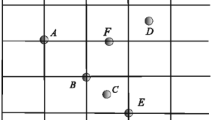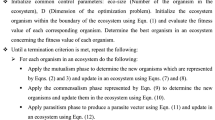Abstract
A simple immune-based multi-objective optimizer (IBMO) is proposed, and a rigorous running time analysis of IBMO on three proposed bi-objective pseudo-Boolean functions (Bi-Trap, Bi-Plateau and Bi-Jump) is presented. The running time of a global simple evolutionary multi-objective optimizer (GSEMO) using standard bit mutation operator with IBMO using somatic contiguous hypermutation (CHM) operator is compared with these three functions. The results show that the immune-based hypermutation can significantly beat standard bit mutation on some well-known multi-objective pseudo-Boolean functions. The proofs allow us to understand the relationship between the characteristics of the problems and the features of the algorithms more deeply. These analysis results also give us a good inspiration to analyze and design a bio-inspired search heuristics.
Similar content being viewed by others
References
HANNE T. Global multiobjective optimization with evolutionary algorithms: Selection mechanisms and mutation control [C]//Evolutionary Multi-Criterion Optimization. Ouro Preto, Brazil: EMO, 2001: 197–212.
LAUMANNS M, THIELE L, ZITZLER E. Archiving with guaranteed convergence and diversity in multiobjective optimization [C]//Genetic and Evolutionary Computation Conference. New York, USA: Morgan Kaufmann Publishers, 2002: 439–447.
LAUMANNS M, THIELE L, ZITZLER E. Running time analysis of multiobjective evolutionary algorithms on pseudo-Boolean functions [J]. IEEE Transaction on Evolutionary Computation, 2004, 8(2): 170–182.
LAUMANNS M, THIELE L, ZITZLER E. Running time analysis of evolutionary algorithms on a simplified multiobjective knapsack problem [J]. Natural Computing, 2004, 3(1): 37–51.
SCHARNOW J, TINNEFELD K, WEGENER I. Fitness landscapes based on sorting and shortest paths problems [C]//International Conference on Parallel Problem Solving from Nature. Berlin, Germany: Springer-Verlag, 2002: 54–63.
QIAN C, YU Y, ZHOU Z H. An analysis on recombination in multi-objective evolutionary optimization [J]. Artificial Intelligence, 2013, 204: 99–119.
PENG X, XIA X Y, LIAO W Z, et al. Running time analysis of the Pareto archived evolution strategy on pseudo-Boolean functions [J]. Multimedia Tools and Applications, 2018, 77(9): 11203–11217.
XIA X Y, PENG X, DENG L Y, et al. Performance analysis of evolutionary optimization for the bank account location problem [J]. IEEE Access, 2018, 6: 17756–17767.
KELSEY J, TIMMIS J. Immune inspired somatic contiguous hypermutations for function optimisation [C]//Genetic and Evolutionary Computation Conference. Chicago, IL, USA: Springer-Verlag, 2003: 207–218.
XIA X Y, ZHOU Y R. On the effectiveness of immune inspired mutation operators in some discrete optimization problems [J]. Information Sciences, 2018, 426: 87–100.
JANSEN T, ZARGES C. Analysis of randomised search heuristics for dynamic optimization [J]. Evolutionary Computation, 2015, 23(4): 513–541.
JANSEN T, ZARGES C. Computing longest common subsequences with the B-cell algorithm [C]//International Conference on Artificial Immune Systems. Taormina, Italy: Springer-Verlag, 2012: 111–124.
JANSEN T, ZARGES C. Re-evaluating immuneinspired hypermutations using the fixed budget perspective [J]. IEEE Transactions on Evolutionary Computation, 2014, 18(5): 674–688.
XIA X Y, ZHOU Y R. Performance analysis of immune inspired B-cell algorithm for the SAT problem [J]. Microelectronics and Computer, 2016, 33(7): 5–10 (in Chinese).
NEUMANN F. Expected runtimes of a simple evolutionary algorithm for the multi-objective minimum spanning tree problem [J]. European Journal of Operational Research, 2007, 181(3): 1620–1629.
NEUMANN F, WEGENER I. Minimum spanning trees made easier via multi-objective optimization [J]. Natural Computing, 2006, 5 (3): 305–319.
LAI X S, ZHOU Y R, HE J, et al. Performance analysis of evolutionary algorithms for the minimum label spanning tree problem [J]. IEEE Transactions on Evolutionary Computation, 2014, 18(6): 860–872.
FRIEDRICH T, HEBBINGHAUS N, NEUMANN F, et al. Approximating covering problems by randomized search heuristics using multi-objective models [C]//Genetic and Evolutionary Computation Conference. London, UK: ACM, 2007: 797–804.
JANSEN T, ZARGES, C. Analyzing different variants of immune inspired somatic contiguous hypermutations [J]. Theoretical Computer Science, 2011, 412(6): 517–533.
MITZENMACHER M, UPFAL E. Propability and computing: Randomized algorithms and probabilistic analysis [M]. Cambridge, UK: Cambridge University Press, 2005.
JANSEN T, WEGENER I. Evolutionary algorithms: How to cope with plateaus of constant fitness and when to reject strings of the same fitness [J]. IEEE Transactions on Evolutionary Computation, 2001, 5(6): 589–599.
DROSTE S, JANSEN T, WEGENER I. A rigorous complexity analysis of the (1+1) evolutionary algorithm for separable functions with Boolean inputs [J]. Evolutionary Computation, 1998, 6(2): 185–196.
Author information
Authors and Affiliations
Corresponding author
Additional information
Foundation item: the National Natural Science Foundation of China (Nos. 61703183, 61773410, 61375053), and the Public Welfare Technology Research Plan of Zhejiang Province (No. LGG19F030010)
Rights and permissions
About this article
Cite this article
Zhou, S., Peng, X., Wang, Y. et al. Rigorous Running Time Analysis of a Simple Immune-Based Multi-Objective Optimizer for Bi-Objective Pseudo-Boolean Functions. J. Shanghai Jiaotong Univ. (Sci.) 23, 827–833 (2018). https://doi.org/10.1007/s12204-018-2004-z
Received:
Published:
Issue Date:
DOI: https://doi.org/10.1007/s12204-018-2004-z




